| Back Number | No.17 2005/06/08 | |||
| News | Nature’s Wisdom Award Announced |  |
||
| Pavilions | Caucasus Pavilion (Global Common 4) Iran Pavilion (Global Common 1) Turkey Pavilion (Global Common 3) Jordan Pavilion (Global Common 3) |
|||
| Column | Nature Experience Program | |||
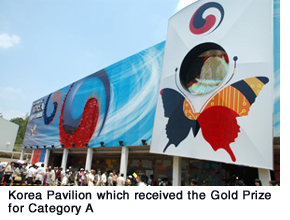 On May 26, the Japan Association for the 2005 World Exhibition announced the results of the first of the Nature’s Wisdom Award. All 120 officially participating countries and international organizations aside from Japan are the object of the Nature’s Wisdom Award. Evaluations were made by nine Japanese and overseas influential key individuals commissioned by the Japan Association for the 2005 World Exhibition who served as members of the jury.
On May 26, the Japan Association for the 2005 World Exhibition announced the results of the first of the Nature’s Wisdom Award. All 120 officially participating countries and international organizations aside from Japan are the object of the Nature’s Wisdom Award. Evaluations were made by nine Japanese and overseas influential key individuals commissioned by the Japan Association for the 2005 World Exhibition who served as members of the jury.In the evaluation, the pavilions were placed into one of four categories* according to its scale, and the members evaluated all target pavilions and selected the winners of three prizes (Gold, Silver and Bronze) for each category. The winners of the Gold Prize were as follows. Category A: Korea Pavilion; Category B: Turkey Pavilion; Category C: Philippine Pavilion; and Category D: Bolivarian Republic of Venezuela (Andean Amazonian Pavilion). The evaluations were made from such points of view as the quality of the interior and exteior décor, the quality of the exhibits, relevance of the physical displays to the theme, functionality and cleanliness. The second meeting of the jury is scheduled to take place in September. At that time, the focus of the evaluations will be on the messages based on the Nature’s Wisdom theme that is being communicated to the world by official participants for the resolution of today’s global issues regarding nature conservation and to highlight the value of biodiversity, cultural diversity, mutual understanding, and the promotion of international exchange. The official award ceremony for the Nature’s Wisdom Award will be held in September together with the presentation of awards to the pavilions that receive prizes after the second meeting of the jury. The pavilions which received prizes are as follows: |
||||||||||||||||||||||||||||||||||||||||
|
||||||||||||||||||||||||||||||||||||||||
| *Note: Categorization method EXPO 2005 Aichi, Japan uses the “module” method and provides standardized modules, or lots of land and buildings to participating countries and international organizations for their exhibits. The size of one module is 18m x 18m x 9m (L, W, H). Pavilions were categorized according to the number of modules they consisted of. Category A: 4 modules or more; Category B: 1.5 to 3 modules; Category C: 1 module or less. Meanwhile, Category D is for joint pavilions. |
![]()
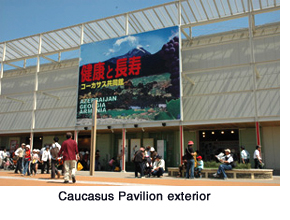 The Caucasus, sandwiched between the Black Sea (to the west) and the Caspian Sea (to the east), is a region known around the world for health and longevity. It is a region that served as a transit point on the ancient Silk Road and is seeped in history. The three countries exhibiting in the Caucasus Pavilion - the Republic of Armenia, Georgia and the Republic of Azerbaijan - lay to the south of the Caucasus Mountains, a range that stretches east to west.
The Caucasus, sandwiched between the Black Sea (to the west) and the Caspian Sea (to the east), is a region known around the world for health and longevity. It is a region that served as a transit point on the ancient Silk Road and is seeped in history. The three countries exhibiting in the Caucasus Pavilion - the Republic of Armenia, Georgia and the Republic of Azerbaijan - lay to the south of the Caucasus Mountains, a range that stretches east to west.The theme of the joint pavilion is “Health and Longevity.” Armenia is exhibiting under the sub-theme “stone,” while “wood” and “fire” is, respectively, the sub-theme of the exhibits of Georgia and Azerbaijan. More than 90% of Armenia’s national territory is in the highlands at an altitude above 1,000m. There are also 3,000-meter-class mountains all over the country. Yerevan, the capital city that is said to have existed since the 7th century BC, is lined with buildings constructed of colorful tuff (a type of volcanic rock composed of volcanic ash), including those of a rose color. The displays at this exhibit themed “stone” also attract the eye. It includes photos of stone-built churches that are said to be the ancestor of European church architecture, numerous beautiful items made of stone, and of course honey, herbs, Armenian cognac and other products related to health and longevity. |
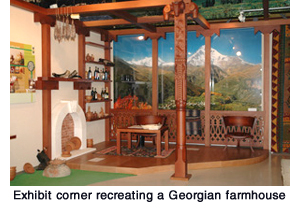 Japan is a nation well known for its very high average life expectancy. Even then, while the average number of those aged 100 or older in Japan per 100,000 people is 6.8, Georgia boasts 17 such people per 100,000. With choirs composed entirely of those aged 100 and over in the country, it seems that Georgia’s centenarians are quite active, too.
Japan is a nation well known for its very high average life expectancy. Even then, while the average number of those aged 100 or older in Japan per 100,000 people is 6.8, Georgia boasts 17 such people per 100,000. With choirs composed entirely of those aged 100 and over in the country, it seems that Georgia’s centenarians are quite active, too.Georgia’s exhibit corner is a recreated farmhouse decorated with beautiful woodcarvings. If you sit in the terrace in front of the photo of the mountains that spreads before your eyes, it is almost as if you are surrounded by the sun and clean air of Georgia’s countryside, and you get a sense of the happiness that the people living as a large family in this nation experience. Buried near the terrace is a fermenting jar for Georgian wine, something which even Cleopatra is said to have been fond of. The exhibit area introduces various sources of health and longevity, including a Georgian yogurt developed especially for EXPO 2005 Aichi, Japan. Azerbaijan is considered by some to be the birthplace of Zoroastrianism, thought to have arisen from the divine nature that people felt in the fires that burned ceaselessly in the desert. The source of these fires was perhaps the natural gas and oil contained beneath the ground. A miniature model of the pipeline that extends from the Caspian Sea to the rich, green area is displayed at the entrance of the Azerbaijan corner. They say that it expresses the country’s eagerness to utilize the wealth of income it has derived from oil and natural gas to environmental conservation through means such as afforestation and irrigation. Its health-related displays, including pomegranates said to have been contributed for the treatment of the victims of the Chernobyl nuclear reactor accident, is quite interesting. Another popular corner of this joint pavilion is the Caucasus Restaurant. Here, visitors can savor not only yogurt but also meat and vegetable kebabs wrapped in a type of crepe, and a bright red Caucasus stew of tomatoes, onions and other ingredients cooked for three hours. The soft-serve ice cream filled with rose, lavender and other essences is proving very popular among women. |
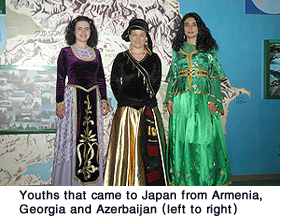 Among the people working adorned in beautiful ethnic costumes working at this restaurant as well as shops selling health foods and other items are three youths each from each country that have been chosen at the recommendation of university presidents. They are students who began studying Japanese after getting to know and being attracted to the Japanese culture. EXPO 2005 has become a perfect opportunity for them to visit this country of their interest.
Among the people working adorned in beautiful ethnic costumes working at this restaurant as well as shops selling health foods and other items are three youths each from each country that have been chosen at the recommendation of university presidents. They are students who began studying Japanese after getting to know and being attracted to the Japanese culture. EXPO 2005 has become a perfect opportunity for them to visit this country of their interest.The people of the Caucasus, a region with no small amount of conflict, are reaching out to each other as they exhibit and spend a long time together at this joint pavilion. This is another realization of the Grand Intercultural Symphony, a concept of EXPO 2005. |
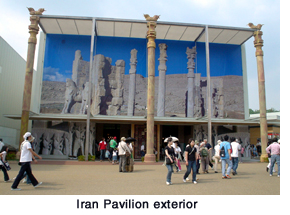 The pavilion with a large Persian carpet depicting Morizo and Kiccoro adorning the entrance is the Iran Pavilion.
The pavilion with a large Persian carpet depicting Morizo and Kiccoro adorning the entrance is the Iran Pavilion.Inside, visitors will find themselves in a large inner courtyard of an Iranian home. At its center is a cool looking pool of water with benches set around it. A corridor runs along the second story. The air blowing in from above the open courtyard is cooled by the pool providing coolness. It is a result of the wisdom of the people of Iran nurtured since the dawn of history. The many rooms facing the courtyard serve as themed exhibit areas or shops selling Persian carpets and other items. One of the exhibits that attract the eye is themed “Children, Families and Lifestyles.” Here, visitors will find valuable exhibits from ancient times to the modern day, including clay tablets that children used at around 2000BC - 1500BC to learn cuneiform script. If visitors want to rest, they can sit at the pool-side bench and sip tea Iranian-style with a sugar cube in their mouth. It should be quite enjoyable gazing at the beautiful tapestries decorating the walls while contemplating the long history of Iran since the days that the country was known as Persia. |
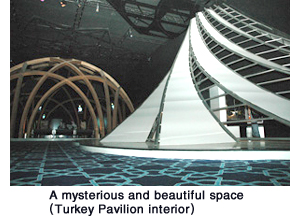 The theme of the Turkey Pavilion, which received the Gold Prize of the Nature’s Wisdom Award announced on May 26, is “Art in Nature, and Nature in Art.” The appeal of this pavilion, above anything else, is the mystical, beautiful space created within and the structures that comprise it.
The theme of the Turkey Pavilion, which received the Gold Prize of the Nature’s Wisdom Award announced on May 26, is “Art in Nature, and Nature in Art.” The appeal of this pavilion, above anything else, is the mystical, beautiful space created within and the structures that comprise it.Two white structures give forth the impression of the wide skirts of the Whirling Dervishes - the mystic Islamic Mevlevi Order - which sweep the earth as they spin and pray in remembrance of God. The half-sphere construction supported by beams situated between the two structures represents the universe. The white marble sculpture at the center of this construction is filled with water, which symbolizes the center of the universe. And, when visitors glance down, their vision is filled with two-dimensional geometric patterns that spread throughout this space into the third dimension of the structures, and they cannot help but feel a mysterious sense; it is as if they become enveloped by the geometric patterns. The many screens set up at various points project the flow from the creations of nature, such as snow crystals and roses, to the beautiful geometric patterns of Islamic-Turkish art. Visitors who stop and stand in this pavilion are swept into a world of the universe, nature and the art that was born from them, thereby becoming one. |
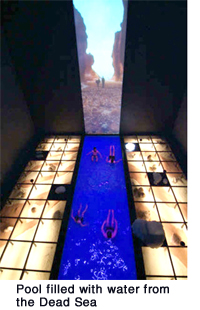 The theme of the Jordan Pavilion is “Silent Flotation.” It features the Dead Sea, which is located 400 meters below sea level (“The Lowest Point on Earth”). The Dead Sea contains more than 35 minerals including magnesium, calcium, bromine and potassium; some of these minerals are not found in any ocean. Additionally, it is well known for implanting a relaxing feeling, nourishing the skin, activating the circulatory system and for easing rheumatic discomfort and metabolic disorders. The mineral concentration in the Dead Sea is about ten times the salinity of the oceans.
The theme of the Jordan Pavilion is “Silent Flotation.” It features the Dead Sea, which is located 400 meters below sea level (“The Lowest Point on Earth”). The Dead Sea contains more than 35 minerals including magnesium, calcium, bromine and potassium; some of these minerals are not found in any ocean. Additionally, it is well known for implanting a relaxing feeling, nourishing the skin, activating the circulatory system and for easing rheumatic discomfort and metabolic disorders. The mineral concentration in the Dead Sea is about ten times the salinity of the oceans.If you look down from the second floor corridor of the Jordan Pavilion, you will get a glimpse of people floating in the darkness below in an elongated pool filled with Dead Sea water. A giant screen in front projects images of the Dead Sea and its surroundings. Then, a soft light begins to shine from the pool side, gradually showing the entire space with its displays of white natural Dead Sea salt crystals. What is enjoyable about this pavilion is that visitors can go into the pool and actually experience the Dead Sea water. It is a magical, relaxing sensation, as if you are in a weightless state! In this magical pavilion, visitors are a part of the exhibit. People look on them stretching and relaxing on their backs from the second floor. Visitors can enjoy the marvelous experience of the Dead Sea Mud facials at the spa located on the first floor; they can also take the Dead Sea to their homes by buying the Dead Sea mud, bath salt and other products from the shop. |
![]()
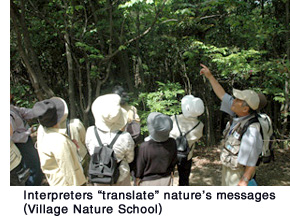 With Nature’s Wisdom as the main theme, EXPO 2005 Aichi, Japan is providing an entertaining experience to visitors through various pavilions, exhibits and events. This time, let us take a look at another way to enjoy EXPO 2005 - the Nature Experience Program that takes nature itself and turns it into a pavilion.
With Nature’s Wisdom as the main theme, EXPO 2005 Aichi, Japan is providing an entertaining experience to visitors through various pavilions, exhibits and events. This time, let us take a look at another way to enjoy EXPO 2005 - the Nature Experience Program that takes nature itself and turns it into a pavilion.The Seto Area, surrounded by forest, is where the Satoyama Trail Zone is located. This zone allows people to enjoy the lush nature of the Satoyama (village hills and mountains) landscape. Herein lays the Village Nature School. The starting point is the Sato Visitors Center located in a corner of the Kaisho Plaza near the Civic Pavilion. Here, visitors choose a course that they like from various trails of between roughly 40 and 75 minutes in duration. The capacity of each course is about 10 to 15 people. All courses are led by forest guides called “interpreters.” The “Mountain Trail Course” takes participants on a leisurely paced walk through a mountain trail while listening to the songs of birds and appreciating the trees and flowers of the forest. Getting a view of the mountains at a distance beyond the Kaisho Forest from an observation deck on Monomi Hill is also exhilarating. In the “Gully Trail Course,” visitors walk under the bright early-summer sunshine while listening to the babble of a stream flowing through a gully. Other courses include a historic ceramics kiln course in which participants make clay, which is proving popular among children, a course for enjoying the forest in the rain, and a variety of other ways to enjoy the forests of the Satoyama. |
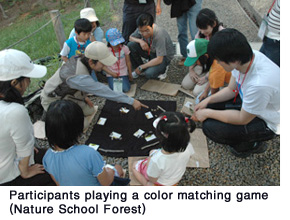 The Forest Experience Zone in the Nagakute Area is divided into the North Forest and South Forest. The Nature School Forest uses these forests as a pavilion. There are two types of courses here: a self-guided course in which participants can freely stroll around the forest at their preferred pace, and an interpreter-guided course.
The Forest Experience Zone in the Nagakute Area is divided into the North Forest and South Forest. The Nature School Forest uses these forests as a pavilion. There are two types of courses here: a self-guided course in which participants can freely stroll around the forest at their preferred pace, and an interpreter-guided course.In the “Picture Book Path” course, participants take a walk through the forest with a map in hand. After receiving an orientation at the entrance of the North Forest, they follow illustrated panels set up along the way and stroll at their own pace. Seeing the happy faces of children who receive a picture book at the exit containing a collection of the illustrated panels brings smiles to the faces of parents, too. The “Interpreter-guided Forest Tour” is a walk through the South Forest. It starts from the Forest Visitors Center located close to EXPO Dome and by Kame-no-ike Pond. In this tour, interpreters, who are skilled at finding fun ways to play in nature, provide participants with opportunities to experience nature deeply through fun and games. For example, there is the color matching game. Participants split up into teams and look for designated colors of nature in the forest. Families walk around trees, search through fallen leaves and become engrossed in trying to find the designated color. After the game is over, you hear comments from children such as, “I was surprised when I realized as I was searching that there are so many different colors in the forest.” The content of the program and games played change continually to match the changes in the seasons. |
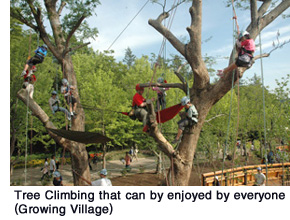 The Growing Village in the Interactive Fun Zone is where visitors can gain valuable experiences on the wonder and joy of nature. A popular program here is Tree Climbing using a rope and harness.
The Growing Village in the Interactive Fun Zone is where visitors can gain valuable experiences on the wonder and joy of nature. A popular program here is Tree Climbing using a rope and harness.The carefree expressions on children’s faces gradually become serious as instructors begin to outfit them with harnesses. The mother, who will be climbing the tree with the children, seems a little worried, too. After some trial and error, they all get the hang of it and start climbing the tree skillfully. The children climb higher and higher, and even the mother seems to have forgotten about her children, repeatedly saying, “This feels so good! It’s great!” It is a program that thoroughly engrosses children and adults alike. Why not enjoy an experience in nature, which is another pavilion at EXPO 2005? |
| EXPO 2005 AICHI, JAPAN Newsletter | |
| To read past issues:Back Number | |
| Editor/Publisher: Japan Association for
the 2005 World Exposition Head Office: 1533-1 Ibaragabasama, Nagakute-cho Aichi 480-1101 Japan Nagoya Office: Nagoya Daiya II Bldg 4F, 3-15-1 Meieki Nakamura-ku, Nagoya, Aichi 450-0002 Japan Tokyo Office: Iino Bldg 8F, 2-1-1 Uchisaiwai-cho Chiyoda-ku, Tokyo 100-0011 Japan |
 |
© Japan Association for the 2005 World Exposition
